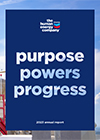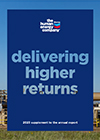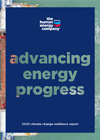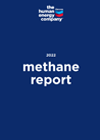air emissions
protecting air quality
Chevron is committed to protecting air quality by managing emissions from our operations. Our air emissions Corporate Core Environmental Aspect* includes criteria pollutants [oxides of nitrogen (NOx), oxides of sulfur (SOx) and particulate matter (PM)], volatile organic compounds (VOCs) and hazardous air pollutants. Not included in our definition of air emissions are greenhouse gases (GHGs), including methane. GHGs are included as a separate environmental aspect: energy efficiency and greenhouse gas.
management of air emissions
The expectations in our updated Operational Excellence Management System (OEMS) include that our organizations reduce air emissions using a risk-based approach that addresses potential acute and cumulative impacts across the life of our assets. Organizations monitor and analyze performance to verify that the safeguards designed to reduce air emissions are in place and functioning. Our Environmental Stewardship (ES) process and our Upstream-specific Air Emissions Environmental Performance Standard (Air Emissions EPS) are examples of how we execute the air emissions-related expectations of our OEMS.
The ES process directs our businesses to create an inventory of how their activities interact with the environment. These environmental aspects, including air emissions, and their related potential impacts are then used to identify, assess and prioritize environmental risk and improvement opportunities.
Our Air Emissions EPS is applied across our upstream businesses and capital projects and sets an expectation to conduct an air quality impact assessment for certain equipment. If needed, based on the results of the impact assessment, the Air Emissions EPS specifies design requirements, such as equipment emission standards and control technologies, to reduce air emissions from our new capital projects. Our Air Emissions EPS also sets forth leak detection and repair programs to reduce emissions of VOCs from sources that meet the applicability requirements of the standard.
We have also made significant investments in equipment to reduce air emissions associated with our refinery operations and to meet regulatory requirements.
reporting our performance
At Chevron, we aim to achieve results and enhance transparency by annually reporting environmental metrics and performance data. Throughout 2022, we have engaged upstream and refining operations to better understand environmental performance and develop insights into improvement opportunities. We also continue to work to better understand non–greenhouse gas air emissions. Learn more about our performance data below.
14%
decrease in nitrogen oxides emissions since 2018
21%
decrease in volatile organic compounds emissions since 2018
success stories
Singapore
The Singapore Refining Company, a joint venture in which Chevron holds a 50% interest, completed a major capital project in 2017 that resulted in a reduction in SOx emissions and increase in energy efficiency. The $500 million project involved constructing gasoline clean fuels units and a dual-train cogeneration plant (“Mogas Cogen”), as well as retrofits to existing furnaces to burn cleaner natural gas.
In addition, SRC has also implemented sulphur recovery projects that reduce SOx emissions. All the above projects support the Singapore government’s goals of a cleaner environment and a more efficient energy industry. In addition, the refinery is now producing higher-quality and cleaner-burning gasoline for the Singapore and Malaysia markets.
Richmond, California
Refinery modernization project
In 2019, we completed primary construction of the major components of our Refinery Modernization Project, a major investment to enable us to deliver the energy that improves lives, with less environmental impact. The project is a great example of efforts to improve energy efficiency, reduce air emissions overall and increase the safety and reliability of the refinery. Project upgrades include:
- a new hydrogen processing plant that is 20% more fuel efficient
- Piping circuits with greater resistance to corrosion
- Two tanker vessels that meet Tier 3 emission standards
- Domes to fuel storage tanks
- low-nitrogen oxide furnaces and wet electrostatic precipitators to reduce air emissions.
In addition, Chevron worked with a tugboat operator to commission a new multipurpose boat as part of the refinery’s commitment under the Modernization Project. The Caden Foss tugboat is one of the first of its kind and complies with the Environmental Protection Agency’s Tier 4 emission standards for new nonroad diesel engines. Use of this new tugboat will decrease PM and NOx emissions from operations near Chevron’s Richmond Long Wharf.
Community air monitoring program in California
Air monitoring is one of the tools used to measure emissions and help the public better understand local air quality. Since 2013, our refinery in Richmond, California has funded a community air monitoring program. The program, which is operated by an independent expert, provides near real-time data 24 hours a day about air quality in the community. Data is collected and reported from three stations along the refinery’s fence line and three neighborhood stations.
Since the launch of the program, the air monitors have continuously tracked air quality and has been a valuable source of information for the community.
environmental management company
*Consistent with ISO (International Organization for Standardization) 14001, we defined seven types of environmental activities, or Corporate Core Environmental Aspects: accidental release prevention and response, air emissions, energy efficiency and greenhouse gas, natural resources (including land, water and biodiversity), site residual impacts, waste, and wastewater.
**Ipieca (the global oil and gas industry association for environmental and social issues)/American Petroleum Institute/International Association of Oil & Gas Producers.
***Operated basis. Transportation includes Chevron Pipe Line Company and Chevron Shipping Company. Other includes Americas Products, International Products, Chevron Lubricants, Chevron Oronite Company, and Chevron Power and Energy Management Company. Air emissions from Chevron Environmental Management and Real Estate Company are excluded from this reporting. For compiling and reporting air emissions data, Chevron follows regulatory definitions of VOCs. SOx emissions include SO2 and SO3, reported as SO2-equivalent. NOx emissions include NO and NO2 (reported as NO2-equivalent) and exclude N2O. Information regarding air emissions from Chevron Phillips Chemical Company LLC can be found at www.cpchem.com.




